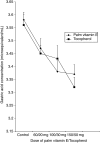Effect of various doses of palm vitamin E and tocopherol on aspirin-induced gastric lesions in rats
- PMID: 12657138
- PMCID: PMC2517694
- DOI: 10.1046/j.1365-2613.2002.00242.x
Effect of various doses of palm vitamin E and tocopherol on aspirin-induced gastric lesions in rats
Abstract
This study examined the effects of vitamin E on the prevention of aspirin-induced gastric lesions. The study was divided into two phases. Phase 1 determined the effects of various doses of palm vitamin E on the factors affecting mucosal integrity. Thirty-two male rats of the Sprague-Dawley strain (200-250 g) were randomly divided into four groups. Group I was fed a normal diet (control), Groups II, III and IV were fed a diet supplemented with palm vitamin E in a dose of 60 mg/kg food, 100 mg/kg food and 150 mg/kg food, respectively. The rats were killed after 4 weeks of feeding for the determination of gastric malondialdehyde (MDA), acid and mucus content. There was a significant decrease in gastric MDA and gastric acid in all the palm vitamin E supplemented groups compared to control. However, these doses of palm vitamin E had no significant effect on gastric mucus. The phase 2 study determined the effect of multiple doses of palm vitamin E and tocopherol on the prevention of aspirin-induced gastric lesions. Fifty rats of the same weight and strain were randomized into seven groups. Group I was fed a normal diet; groups II to IV were fed with a palm vitamin E enriched diet in doses of 60 mg, 100 mg and 150 mg/kg food, respectively; groups V to VII were fed with a tocopherol-enriched diet in doses of 20 mg, 30 mg and 50 mg/kg food, respectively. After 4 weeks of feeding with the respective diets the rats were challenged with a single intra-gastric dose of 400 mg/kg body weight aspirin suspended in propylene glycol. The rats were killed 6 h post-aspirin exposure for the determination of gastric lesion index and gastric parameters as mentioned in the phase I study. The gastric lesions index was significantly lower in all the vitamin E groups compared to control. The lowest ulcer index was observed in the groups that received 100 mg of palm vitamin E and 30 mg tocopherol in the diet. However, there was no significant difference in ulcer indices between palm vitamin E and tocopherol-treated groups. The lower ulcer index was only accompanied by lower gastric MDA content. We conclude that both palm vitamin E in doses of 60 mg, 100 mg and 150 mg/kg food as well as tocopherol in doses of 20 mg, 30 mg and 50 mg/kg food are equally effective in preventing aspirin-induced gastric lesions. The most probable mechanism is through their ability in limiting the lipid peroxidation that is involved in aspirin-induced gastric lesions.
Figures






Similar articles
-
Comparative effects of a tocotrienol-rich fraction and tocopherol in aspirin-induced gastric lesions in rats.Asia Pac J Clin Nutr. 2002;11(4):309-13. doi: 10.1046/j.1440-6047.2002.00298.x. Asia Pac J Clin Nutr. 2002. PMID: 12495264
-
Effect of palm vitamin E on the healing of ethanol-induced gastric injury in rats.Int J Food Sci Nutr. 2000;51 Suppl:S31-41. doi: 10.1080/096374800750049558. Int J Food Sci Nutr. 2000. PMID: 11271855
-
Comparative effect of palm vitamin E and ranitidine on the healing of ethanol-induced gastric lesions in rats.Int J Exp Pathol. 1999 Oct;80(5):259-63. doi: 10.1046/j.1365-2613.1999.00119.x. Int J Exp Pathol. 1999. PMID: 10607016 Free PMC article.
-
Palm vitamin E and the healing of ethanol-induced gastric lesions.Asia Pac J Clin Nutr. 1999 Dec;8(4):258-62. doi: 10.1046/j.1440-6047.1999.00097.x. Asia Pac J Clin Nutr. 1999. PMID: 24394225
-
Effect of vitamin E supplementation on prostaglandin concentrations in aspirin-induced acute gastric injury in aged rats.Am J Clin Nutr. 1997 Nov;66(5):1218-23. doi: 10.1093/ajcn/66.5.1218. Am J Clin Nutr. 1997. PMID: 9356541
Cited by
-
Testosterone and vitamin E administration up-regulated varicocele-reduced Hsp70-2 protein expression and ameliorated biochemical alterations.J Assist Reprod Genet. 2014 Mar;31(3):341-54. doi: 10.1007/s10815-013-0165-0. Epub 2014 Jan 7. J Assist Reprod Genet. 2014. PMID: 24395641 Free PMC article.
-
Antioxidant effect of methanolic extract ofSolanum nigrum berries on aspirin induced gastric mucosal injury.Indian J Clin Biochem. 2004 Jan;19(1):57-61. doi: 10.1007/BF02872391. Indian J Clin Biochem. 2004. PMID: 23105428 Free PMC article.
-
The effects of supplemental zinc and honey on wound healing in rats.Iran J Basic Med Sci. 2011 Jul;14(4):391-8. Iran J Basic Med Sci. 2011. PMID: 23493488 Free PMC article.
-
Protective effects of Dialium guineense pulp on aspirin-induced gastric mucosal injury in albino rats.J Appl Biomed. 2021 Sep;19(3):170-178. doi: 10.32725/jab.2021.015. Epub 2021 Jun 10. J Appl Biomed. 2021. PMID: 34907760
-
Gastro-Protective and Anti-Oxidant Potential of Althaea officinalis and Solanum nigrum on Pyloric Ligation/Indomethacin-Induced Ulceration in Rats.Antioxidants (Basel). 2019 Oct 25;8(11):512. doi: 10.3390/antiox8110512. Antioxidants (Basel). 2019. PMID: 31731465 Free PMC article.
References
-
- Corne SJ, Morissey SM, Woods RJ. A method for quantitative estimation of gastric barrier mucus. J. Physiol. 1974;242:116P–117P. - PubMed
-
- Fajer A, Carneiro HB, Oria H. Effect of vitamin E on the incidence of gastric ulcers in rats on simplified diets. Hospital (Brazil) 1955;48:543–548.
-
- Fauzee AM, Kamsiah J, Gapor MT, Nafeeza MI. Comparative effects of a tocotrienol rich-fraction and tocopherol in aspirin induced gastric lesions rats in Asia. Pacific J. Clin. Nutr. 2002;11:309–313. - PubMed
-
- Granger DN, Hernandez LA, Grisham MB. Reactive oxygen metabolite: Mediators of cell injury in digestive system. Viewpoints Dig. Dis. 1986;18:13–17.
Publication types
MeSH terms
Substances
LinkOut - more resources
Full Text Sources
Medical

